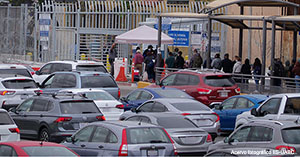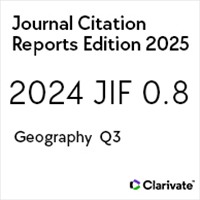Trabajadores transfronterizos o commuters internacionales en la frontera México-Estados Unidos: evolución e importancia económica
Cross-border workers or international commuters at the Mexico-US border: evolution and economic importance
https://doi.org/10.21670/ref.2307118
Palabras clave:
trabajadores transfronterizos, commuters internacionales, compras transfronterizas, frontera México-Estados UnidosResumen
Este artículo analiza la evolución de los trabajadores transfronterizos que residen en México y laboran en Estados Unidos y cuantifica su importancia económica. Con base en información censal y la ENIGH se estiman modelos de regresión lineal y Tobit. Durante el periodo 2000-2020, el número de transfronterizos aumentó ligeramente y la participación de los estadounidenses dentro de este grupo se incrementó sustancialmente. En 2020, los transfronterizos aportaron 7.3% de la masa salarial y ejercieron 7.5% del gasto total de los municipios del norte de México. Además, el tener a un transfronterizo en el hogar se asocia con un gasto 56.8% mayor en México y 283.1% mayor en Estados Unidos. El ser transfronterizo representa para las personas del norte de México con posibilidades de laborar en Estados Unidos una estrategia efectiva para maximizar su ingreso y acceder a un mejor nivel de vida.Abstract This article analyzes the evolution of cross-border workers who reside in Mexico and work in the United States and quantifies their economic importance. Based on census information and the ENIGH, a series of linear regression and Tobit models are estimated. During the 2000-2020 period, the number of cross-border workers grew slightly and the share of US-born within this group increased substantially. In 2020, cross-border workers contributed 7.3% of the salary mass and disbursed 7.5% of the total expenditures made in the municipalities of northern Mexico. Moreover, having a cross-border worker in the household is associated with an expenditure that is 56.8% higher in Mexico and 283.1% higher in the United States. Being a cross-border worker represents an effective strategy for the people from northern Mexico with the possibility of working in the United States to maximize their income and access a better quality of life.
Citas
Acuña González, B. (1988, octubre-diciembre). Transmigración legal en la frontera México-Estados Unidos. Revista Mexicana de Sociología, 50(4), 277-322. https://doi.org/10.2307/3540592 DOI: https://doi.org/10.2307/3540592
Adkisson, R. V. & Zimmerman, L. (2004). Retail trade on the U.S.-Mexico border during the NAFTA implementation era. Growth and Change, 35(1), 77-89. https://doi.org/10.1111/j.0017-4815.2004.00239.x DOI: https://doi.org/10.1111/j.0017-4815.2004.00239.x
Alegría, T. (1990, julio-diciembre). Ciudad y transmigración en la frontera de México con Estados Unidos. Frontera Norte, 2(4), 7-38. https://fronteranorte.colef.mx/index.php/fronteranorte/article/view/1626
Alegría, T. (2002). Demand and supply of Mexican cross-border workers. Journal of Borderlands Studies, 17(1), 37-55. https://doi.org/10.1080/08865655.2002.9695581 DOI: https://doi.org/10.1080/08865655.2002.9695581
Alegría Olazábal, T. (1992). Desarrollo urbano en la frontera México-Estados Unidos. Una interpretación y algunos resultados. Consejo Nacional para la Cultura y las Artes.
Arámburo Vizcarra, G. (1987). Commuters en la frontera México-Estados Unidos. Estudios Fronterizos, 5(12-13), 81-93. https://doi.org/10.21670/ref.1987.12-13.a04 DOI: https://doi.org/10.21670/ref.1987.12-13.a04
Asplund, M., Friberg, R. & Wilander, F. (2007). Demand and distance: evidence on cross-border shopping. Journal of Public Economics, 91(1-2), 141-157. https://doi.org/10.1016/j.jpubeco.2006.05.006 DOI: https://doi.org/10.1016/j.jpubeco.2006.05.006
Bleda Hernández, M. J. & Tobías Garcés, A. (2002). Aplicación de los modelos de regresión tobit en la modelización de variables epidemiológicas censuradas. Gaceta Sanitaria, 16(2), 188-195. https://doi.org/10.1016/S0213-9111(02)71651-8 DOI: https://doi.org/10.1016/S0213-9111(02)71651-8
Borjas, G. J. & Cassidy, H. (2019). The wage penalty to undocumented immigration. Labour Economics, 61, Artículo 101757. https://doi.org/10.1016/j.labeco.2019.101757 DOI: https://doi.org/10.1016/j.labeco.2019.101757
Borjas, G. J. & Katz, L. F. (2007). The evolution of the Mexican-born workforce in the United States. En G. J. Borjas (Ed.), Mexican immigration to the United States (pp. 13-56). University of Chicago Press. DOI: https://doi.org/10.7208/chicago/9780226066684.003.0002
Broersma, L., Edzes, A. & Van Dijk, J. (2022). Commuting between border regions in The Netherlands, Germany and Belgium: an explanatory model. Journal of Borderlands Studies, 37(3), 551-573. https://doi.org/10.1080/08865655.2020.1810590 DOI: https://doi.org/10.1080/08865655.2020.1810590
Cabral, R., García-Flores, F. & Saucedo, E. (2022). The influence of sentiments of economic agents on pedestrians and vehicle crossings along the US-Mexico border. Applied Sciences, 12(5), 1-17. https://doi.org/10.3390/app12052512 DOI: https://doi.org/10.3390/app12052512
Calderón Villarreal, C., Huesca Reynoso, L. & Ochoa Adame, G. L. (2017). Análisis comparativo de la desigualdad salarial entre México y Estados Unidos. Investigación Económica, 76(300), 3-31. https://doi.org/10.1016/j.inveco.2017.02.004 DOI: https://doi.org/10.1016/j.inveco.2017.02.004
Castañeda Pérez, E. (2022). Transborder (in) securities: transborder commuters’ perceptions of U.S. Customs and Border Protection policing at the Mexico-U.S. border. Politics, Groups, and Identities, 10(1), 1-20. https://doi.org/10.1080/21565503.2020.1748066 DOI: https://doi.org/10.1080/21565503.2020.1748066
Chandra, A., Head, K. & Tappata, M. (2014). The economics of cross-border travel. The Review of Economics and Statistics, 96(4), 648-661. https://doi.org/10.1162/REST_a_00404 DOI: https://doi.org/10.1162/REST_a_00404
Chávez, S. (2016). Border lives: fronterizos, transnational migrants, and commuters in Tijuana. Oxford University Press. DOI: https://doi.org/10.1093/acprof:oso/9780199380572.001.0001
Chiswick, B. R. & Miller, P. W. (2010). Occupational language requirements and the value of English in the US labor market. Journal of Population Economics, 23(1), 353-372. https://doi.org/10.1007/s00148-008-0230-7 DOI: https://doi.org/10.1007/s00148-008-0230-7
Coubès, M.-L. (2008). Maquiladora or cross-border commute. The employment of members of households in five Mexican border cities. En R. R. Marquez & H. D. Romo (Eds.), Transformations of la familia on the U.S.-Mexico border (pp. 131-161). Notre Dame Press.
Díaz González, E. & González-König, G. (2016). Análisis de las compras de los consumidores mexicanos en Estados Unidos basado en el gasto de hogares. Estudios Fronterizos, 17(33), 115-140. https://doi.org/10.21670/ref.2016.33.a05 DOI: https://doi.org/10.21670/ref.2016.33.a05
Ericson, A.-S. (1970). The impact of commuters on the Mexican-American border area. Monthly Labor Review, 93(8), 18-27. https://www.jstor.org/stable/41839773
Escala Rabadán, L. & Vega Briones, G. (2005). Living and working as cross-border commuters in the Tijuana-San Diego Region. En R. Kiy & C. Woodruff (Eds.), The ties that bind us: Mexican migrants in San Diego County (pp. 147-174). Center for US-Mexican Studies-UC San Diego.
Estrella Valenzuela, G. (1993). Migración internacional legal desde la frontera norte de México. Estudios Demográficos y Urbanos, 8(3), 559-600. https://doi.org/10.24201/edu.v8i3.886 DOI: https://doi.org/10.24201/edu.v8i3.886
Ferris, J. S. (2000). The determinants of cross border shopping: implications for tax revenues and institutional change. National Tax Journal, 53(4.1), 801-824. https://doi.org/10.17310/ntj.2000.4.01 DOI: https://doi.org/10.17310/ntj.2000.4.01
Ferris, J. S. (2010, diciembre). Quantifying non-tariff trade barriers: what difference did 9/11 make to Canadian cross-border shopping? Canadian Public Policy, 36(4), 487-501. https://doi.org/10.3138/cpp.36.4.487 DOI: https://doi.org/10.3138/cpp.36.4.487
Ford, T. C., Logan, B. & Logan, J. (2009). NAFTA or Nada? Trade’s impact on U.S. border retailers. Growth and Change, 40(2), 260-286. https://doi.org/10.1111/j.1468-2257.2009.00475.x DOI: https://doi.org/10.1111/j.1468-2257.2009.00475.x
Fullerton, T. M., Jr. & Walke, A. G. (2019). Cross-border shopping and employment patterns in the southwestern United States. Journal of International Commerce, Economics and Policy, 10(3), 1-20. https://doi.org/10.1142/S1793993319500157 DOI: https://doi.org/10.1142/S1793993319500157
Gottholmseder, G. & Theurl, E. (2007). Determinants of cross-border commuting: do cross-border commuters within the household matter? Journal of Borderlands Studies, 22(2), 97-112. https://doi.org/10.1080/08865655.2007.9695679 DOI: https://doi.org/10.1080/08865655.2007.9695679
Herzog, L. A. (1990). Border commuter workers and transfrontier metropolitan structure along the United States-Mexico border. Journal of Borderlands Studies, 5(2), 1-20. https://doi.org/10.1080/08865655.1990.9695393 DOI: https://doi.org/10.1080/08865655.1990.9695393
Huber, P. & Nowotny, K. (2013). Moving across borders: who is willing to migrate or to commute? Regional Studies, 47(9), 1462-1481. https://doi.org/10.1080/00343404.2011.624509 DOI: https://doi.org/10.1080/00343404.2011.624509
Instituto Nacional de Estadística y Geografía (Inegi). (2021). Censo de Población y Vivienda 2020. https://www.inegi.org.mx/programas/ccpv/2020/#Publicaciones
Kamin, D. (2022). How the path to homeownership runs through Mexico. The New York Times. www.nytimes.com/2022/07/25/realestate/homeownership-san-diego-tijuana-mexico.html
Kim, T.-K., Horner, M. W. & Marans, R. W. (2005). Life cycle and environmental factors in selecting residential and job locations. Housing Studies, 20(3), 457-473. https://doi.org/10.1080/02673030500062335 DOI: https://doi.org/10.1080/02673030500062335
López Estrada, S. (2020). Cuidado a través de la frontera: trayectorias transfronterizas de cuidados en la región Tijuana-San Diego. Estudios Fronterizos, 21, Artículo e044. https://doi.org/10.21670/ref.2002044 DOI: https://doi.org/10.21670/ref.2002044
Mincer, J. A. (1974). Schooling, experience and earnings. Columbia University Press.
Minnesota Population Center. (2020). Integrated Public Use Microdata Series, International: Version 7.3 [dataset]. IPUMS. https://doi.org/10.18128/D020.V7.3
Nájera-Aguirre, J. N. (2020). Mercado de trabajo transfronterizo México-Guatemala: una construcción desde la experiencia de los trabajadores. Estudios Fronterizos, 21, Artículo e055. https://doi.org/10.21670/ref.2013055 DOI: https://doi.org/10.21670/ref.2013055
Nielsen, S. B. (2001). A simple model of commodity taxation and cross‐border shopping. The Scandinavian Journal of Economics, 103(4), 599-623. https://doi.org/10.1111/1467-9442.00262 DOI: https://doi.org/10.1111/1467-9442.00262
Orraca Romano, P. P. (2015, enero-junio). Immigrants and cross-border workers in the U.S.-Mexico border region. Frontera Norte, 27(53), 5-34. https://doi.org/10.17428/rfn.v27i53.97
Orraca-Romano, P. P. (2019). Cross-border earnings of Mexican workers across the US-Mexico border. Journal of Borderlands Studies, 34(3), 451-469. https://doi.org/10.1080/08865655.2017.1294025 DOI: https://doi.org/10.1080/08865655.2017.1294025
Orraca Romano, P. P. & García Meneses, E. (2016, julio-diciembre). Why are the wages of the Mexican immigrants and their descendants so low in the United States? Estudios Económicos, 31(2), 305-337. https://doi.org/10.24201/ee.v31i2.19 DOI: https://doi.org/10.24201/ee.v31i2.19
Orraca-Romano, P. P. & Vargas‐Valle, E. D. (2020). Drug‐related violence and the decline in the number of Mexican cross‐border workers. Review of Development Economics, 24(2), 485-502. https://doi.org/10.1111/rode.12649 DOI: https://doi.org/10.1111/rode.12649
Patrick, J. M. & Renforth, W. (1996). The effects of the peso devaluation on cross-border retailing. Journal of Borderlands Studies, 11(1), 25-41. https://doi.org/10.1080/08865655.1996.9695481 DOI: https://doi.org/10.1080/08865655.1996.9695481
Rojas Pérez, H. S. (2020, enero-junio). Trabajadores fronterizos para el flujo mercantil global entre México y Centroamérica. Corpus, 10(1), 1-21. https://doi.org/10.4000/corpusarchivos.3587 DOI: https://doi.org/10.4000/corpusarchivos.3587
Ruggles, S., Flood, S., Sobek, M., Brockman, D., Cooper, G., Richards, S. y Schouweiler, M. (2023). IPUMS USA: Version 13.0 [dataset]. IPUMS. https://doi.org/10.18128/D010.V13.0
Sarabia, H. (2016). Borderland attachments: citizenship and belonging along the U.S.-Mexico border. Citizenship Studies, 20(3-4), 342-358. https://doi.org/10.1080/13621025.2016.1158352 DOI: https://doi.org/10.1080/13621025.2016.1158352
Savage, V. H. & Blankmeyer, E. (1990). A test of purchasing power parity: Texas border retail trade and the value of the peso 1976-1987. Journal of Borderlands Studies, 5(1), 67-78. https://doi.org/10.1080/08865655.1990.9695387 DOI: https://doi.org/10.1080/08865655.1990.9695387
Spierings, B. & Van der Velde, M. (2013). Cross-border differences and unfamiliarity: shopping mobility in the Dutch-German Rhine-Waal Euroregion. European Planning Studies, 21(1), 5-23. https://doi.org/10.1080/09654313.2012.716236 DOI: https://doi.org/10.1080/09654313.2012.716236
Tobin, J. (1958, enero). Estimation of relationships for limited dependent variables. Econometrica, 26(1), 24-36. https://doi.org/10.2307/1907382 DOI: https://doi.org/10.2307/1907382
U. S. Department of State. (s. f.). Border crossing card. https://travel.state.gov/content/travel/en/us-visas/tourism-visit/border-crossing-card.html
Vargas Valle, E. D. & Coubès, M.-L. (2017, enero-junio). Working and giving birth in the United States: changing strategies of transborder life in the north of Mexico. Frontera Norte, 29(57), 63-88. https://doi.org/10.17428/rfn.v29i57.912
Velasco Ortiz, L. (2016, otoño). Cross-border mobility and clandestine practices: scenarios of violence in the Mexico-United States border region. Human Organization, 75(3), 269-278. https://www.researchgate.net/publication/306931290_Cross-border_Mobility_and_Clandestine_Practices_Scenarios_of_Violence_in_the_Mexico-United_States_Border_Region DOI: https://doi.org/10.17730/1938-3525-75.3.269
White, H. (1980). A heteroskedasticity-consistent covariance matrix estimator and a direct test for heteroskedasticity. Econometrica, 48(4), 817-838. https://doi.org/10.2307/1912934 DOI: https://doi.org/10.2307/1912934
































